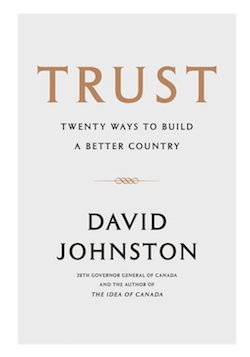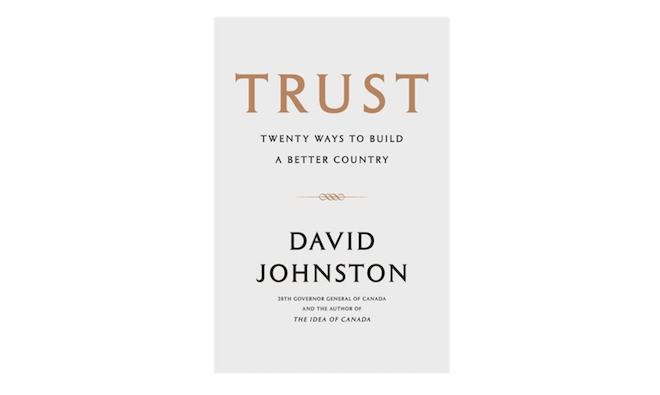What do low confidence in institutions and dissatisfaction with leadership have in common? Trust – or, rather, the lack thereof. In his new book, Canada’s former Governor General, the Right Honourable David Johnston, suggests twenty ways we can earn trust and build a better country.
Wise maxims, like “disclose fully and truly, share credit, accept responsibility,” (18) offer a road map for aspiring leaders. Not all are suited to such roles; as such, existing and aspiring leaders would do well to ask themselves some tough questions, such as:
- What is my motivation to lead?
- Am I deliberately putting we before me?
- Do I exhibit behaviours that make me worthy of people’s trust? Am I direct and true when engaging others?
- Am I interested in the views of my team and do I routinely create opportunities to listen to them? And am I brave enough to validate my thinking with my team and invite their constructively critical consideration?
- In everything I undertake, do I start from a premise of doing the right thing?
Leadership is, of course, not restricted to occupying a formal position, but serving in one is nevertheless a privilege.We should maintain very high qualification standards for such roles. Formal leadership is both a special calling and weighty responsibility. Teams can rightfully expect their leaders to welcome constructive criticism (i.e., tactfully delivered criticism that facilitates improvement), and for that reason, the role is not for the faint of heart or those who might suffer easily bruised egos.

Team members also have a corresponding responsibility to be kind. Fair team members recognize the fallibility of us all. Kind team members do not dismiss well-intentioned leaders when they occasionally miss the mark. Being both kind and constructively critical of our leaders are perhaps the best ways to support and challenge them.
To lead is to put oneself forward in the crosshairs of responsibility, and to be ready to claim responsibility for the team’s failures. Johnston recounts how, when he was principal of McGill University, an issue arose. When no one would take responsibility, his valued colleague and dean stepped in, spoke clearly to the matter and “took responsibility because he saw the urgent need for someone in authority to act in a way to preserve trust.” (18) Responsible leaders step up, and in doing so, they help preserve and foster trust.
One of Johnston’s greatest contributions is emphasizing that leadership is all about the team and not the leader. Far too often, individuals seek out positions of leadership for reasons of ambition or avarice. However, wise is a leader who recognizes that “you can accomplish so much more if you insist on never receiving credit” for your team’s achievements. In Johnston’s words, “Leadership is recognizing your total dependence on the people around you.” (217) A leader’s greatest reward is seeing their team succeed.
Naturally, the challenges before us are bigger than any one of us. As such, Johnston contends that having articles of faith (whatever those may be) and believing in something bigger than yourself makes you “more worthy of trust in the eyes of others.” (68) Moreover, such belief can also inform the personal principles that guide one’s decisions and actions. By knowing your why and having a clear set of values, you will be able to follow Johnston’s precept of “to thine own self be true.” (19)
An unexplored but equally important dimension for trust is the need for our institutions to reflect the diversity of Canada. It is an important component of trust that we are all able to see ourselves in the institutions that serve us. As such, one task of a modern leader is to ensure that our teams mirror our country and not simply one’s own self-image. Instead of simply sending the elevator back down, leaders might invite deserving colleagues of diverse backgrounds to ride up with them.
In addition to consciously building demographic diversity in our teams, there is also a corresponding need to build teams with a diversity of thought. Our best decision-making comes from the full and fair consideration of a variety of perspectives. As Johnston urges: “Those doing the talking have a responsibility to test their ideas with peers before advocating that the entire organization adopt their suggestions.” (30) The broader your team’s diversity of thought, and the more you use it as a lens through which to evaluate ideas, the better your decision-making will be.
Diversity of thought can also be a wellspring of great ideas. As Johnston wisely states: “Diversity is a creative force.” (29) In addition to its creative potential, actively engaging your team is key to building trust because it conveys respect for their advice, makes them a part of decision-making and affords them satisfaction in your collective achievement. As Johnston explains: “Listening […] makes for a more productive workplace. Most people want to go home after a long day and feel they have contributed to something important. They are much more likely to feel that way when they are listened to.” (29) Leaders listen first.
However, a word of caution to those thinking they can simply go through the motions. Johnston warns that “people recognize […] insincerity pretty quickly.” (32) Insincere efforts to engage are sure to poison the well rather than preserve it. Johnston forewarns, “If an organization sets up a system through which to listen, and it does not act consistently with respect to what it is being told, then it has dashed expectations, diminished trust, and done more harm than good.” (30)
To lead effectively, one must enjoy working with people, learning from themand fostering their potential. Indeed, it’s fair to say that if you dislike engaging with people, then you should seriously consider whether a leadership role is for you. Increasingly, effective leaders are identified by their EQ (emotional intelligence or emotional quotient) and not merely by their IQ (or intelligence quotient). Johnston defines emotional intelligence quite simply as the “act of listening to and empathizing with another person – and using that listening and empathizing to inform your decisions and actions.” (27) EQ is about developing effective relationships with everyone you work with and finding ways to achieve results together. No effective leader ever stands alone.
Johnston reveals how trust in our institutions and processes is critical to the well-oiled functioning of our society. Indeed, so true is this that he warns “if this trust dissolves completely, a society can grind to a halt, which leads to chaos and anarchy.” (45) For these institutions and processes to be worthy of our trust, we need to start from doing the right things, rather than simply doing the things right. And “things” is plural for a reason. As Johnston observes, “Knowing there is more than one right way is pluralism.” (114) From our Indigenous, French and English traditions and the increasingly plural character of our country, fitting our institutions and processes to our diverse citizenry is simply part of the great Canadian tradition. As Johnston reminds us, “Confederation is [and has always been] an exercise in pluralism.” (115)
Given the magnitude of some of our key challenges (e.g., climate change, reconciliation, economic opportunity, etc.), effective leadership and trust are essential. To respond to these challenges, we need more leaders who recognize that the tasks before us are bigger than anyone of us, that you can do more with many, and that altruism is the starting point.
How will we know if we’re on track vis-à-vis leading effectively and building trust? General societal satisfaction. As Johnson explains, “Happy societies are trusting societies – both socially and institutionally – and trusting societies are happy societies. It is mutually reinforcing.” (72) With the wisdom Johnston has shared in this great book, we now have a clearer path to follow to lead better and build trust. Let’s get to work.
This review was prepared for Canadian Government Executive (CGE) magazine. Please note the views and opinions expressed in this article are those of the author and do not necessarily reflect the policy or position of CGE or the Government of Canada.

